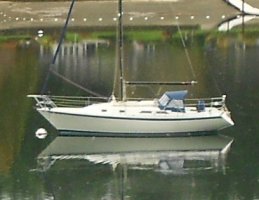I will now shed all semblance of balanced appraisal and generous appreciation of other people's choices and the long tradition here of rational response.
A nutty idea!
Why, for all the mess, the lead will be only somewhat closer to the wheel. And really, when the traveler car is positioned uphill in light air, the mainsheet will entirely block the companionway. And when off the wind, won't the mainsheet bear on the coaming?
People replace the 32-3 traveler with a cabin-house traveler of much longer span, and custom (usually ugly) towers, so as to gain trim possibilities not available with the short stock traveler. That I can see, if I grit my teeth and squint. This change, I can't.
I mean, with a tiller, yeah, maybe--you're sitting there, near the cabin house, and any guests already have to duck and weave to avoid the horrible circumstance of a long stick thingy that sweeps the cockpit every time you tack. But this model was designed for a wheel, with a T-cockpit well, because cruising boats are supposed to be comfortable.
But to play the sheet from the wheel position--what about anybody sitting on the cockpit bench, wouldn't the sheet spill their cocktail, or they'd be sitting on it, or the dog would? Golly, I must be missing something about any reason for this change at all.
I also demand to hear myself say that singlehanding, offshore, which may well be the hidden impulse for more efficient controls in this particular case, the sole operator of the vessel is at the helm 1 percent of the time, since he-she-they-one spends most of one's-them's-her's-his time moving around the cockpit keeping the self -steering gear happy with frequent reefing and unreefing and tweaking sheets, such that the wheel is never touched. I mean, en route Hawaii alone, you never hand-steer.
Beyond such arguments is the change from stock, and the defiance of Bruce KIng by an ordinary mortal, and the addition of more leverage, or easier fine tuning, of mainsheet tension, which is a racing-boat thing, whereas the 32-3 mainsail is small and can be manhandled by a nine-year-old in a gale, compared to racing boats with big mainsails.
I am repulsed by the knowledge that, actually, it's none of my business, and that owners have personalities, and some of them bizarre and with controversial traits such as hating dodgers or setting umbrellas for shade such that children point and giggle, and of always having bananas aboard despite the well-known warnings against (based apparently on rusty banana boats, which when they sank killing all hands left behind for would-be rescuers nothing but a flotilla of yellow floating fruits to mock the mortality of men).
And also, I once did something like the proposed --that is, changed from end-boom sheeting to mid-boom, with a traveler in mid cockpit, and it worked fine but I still have the ankle scars.
Ergo, I would consider taking the lazy way out by monitoring the existing system during the 500-mile singlehanded shakedown cruise--but in the end, of course, I would do what I bloody well want to do, just as you will, too.






